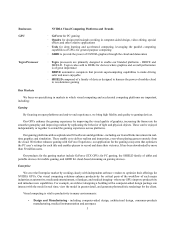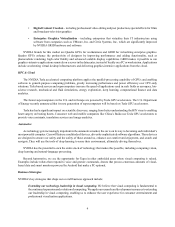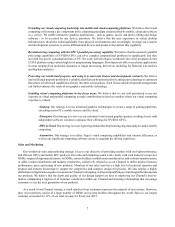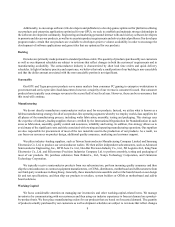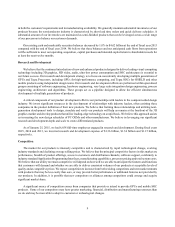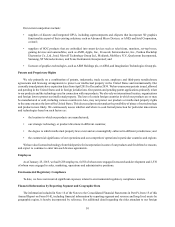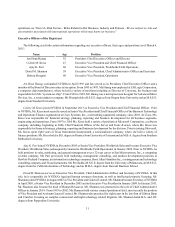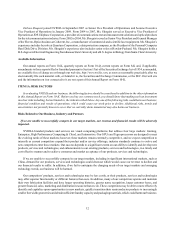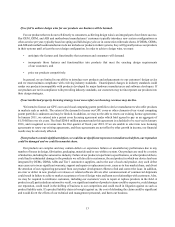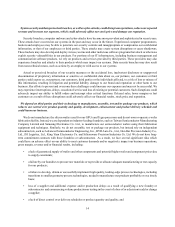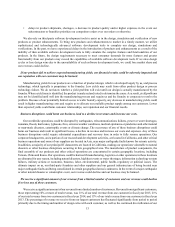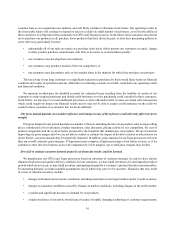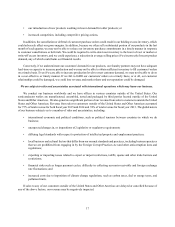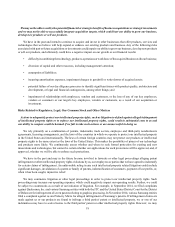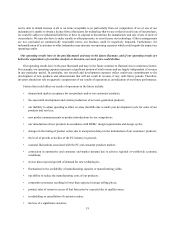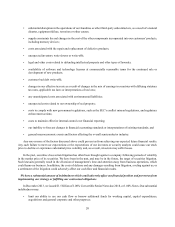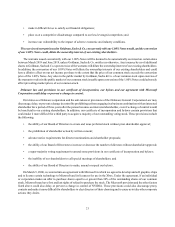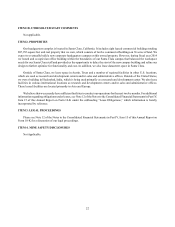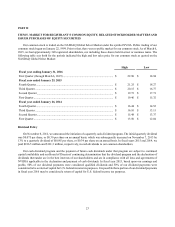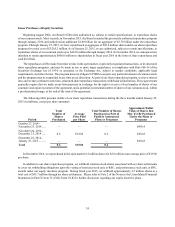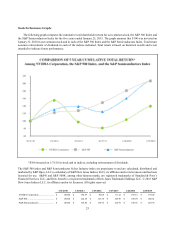NVIDIA 2015 Annual Report Download - page 95
Download and view the complete annual report
Please find page 95 of the 2015 NVIDIA annual report below. You can navigate through the pages in the report by either clicking on the pages listed below, or by using the keyword search tool below to find specific information within the annual report.15
• delays in product shipments, shortages, a decrease in product quality and/or higher expenses in the event our
subcontractors or foundries prioritize our competitors orders over our orders or otherwise.
We also rely on third-party software development tools to assist us in the design, simulation and verification of new
products or product enhancements. To bring new products and enhancements to market in a timely manner, we utilize
sophisticated and technologically advanced software development tools to complete our design, simulations and
verifications. In the past, we have experienced delays in the introduction of products and enhancements as a result of the
inability of then available software development tools to fully simulate the complex features and functionalities of our
products. In the future, the design requirements necessary to meet consumer demands for more features and greater
functionality from our products may exceed the capabilities of available software development tools. If we miss design
cycles or lose design wins due to the unavailability of such software development tools, we could lose market share and
our revenues could decline.
If our products fail to achieve expected manufacturing yields, our financial results could be adversely impacted and
our reputation with our customers may be harmed.
Manufacturing yields for our products are a function of product design, which is developed largely by us, and process
technology, which typically is proprietary to the foundry. Low yields may result from either product design or process
technology failure. We do not know whether a yield problem will exist until our design is actually manufactured by the
foundry. When a yield issue is identified, the product is analyzed and tested to determine the cause. As a result, yield problems
may not be identified until well into the manufacturing process and require us and the foundry to cooperate to resolve the
problem. Because of our potentially limited access to wafer foundry capacity, any decrease in manufacturing yields could
result in higher manufacturing costs and require us to allocate our available product supply among our customers. Lower
than expected yields could harm customer relationships, our reputation and our financial results.
Business disruptions could harm our business, lead to a decline in revenues and increase our costs.
Our worldwide operations could be disrupted by earthquakes, telecommunications failures, power or water shortages,
tsunamis, floods, hurricanes, typhoons, fires, extreme weather conditions, medical epidemics or pandemics and other natural
or man-made disasters, catastrophic events or climate change. The occurrence of any of these business disruptions could
harm our business and result in significant losses, a decline in revenue and increase our costs and expenses. Any of these
business disruptions could require substantial expenditures and recovery time in order to fully resume operations. Our
corporate headquarters, and a portion of our research and development activities, are located in California, and other critical
business operations and some of our suppliers are located in Asia, near major earthquake faults known for seismic activity.
In addition, a majority of our principal IT datacenters are located in California, making our operations vulnerable to natural
disasters or other business disruptions occurring in this geographical area. The manufacture of product components, the
final assembly of our products and other critical operations are concentrated in certain geographic locations, including
Taiwan, China and Korea. Our operations could be harmed if manufacturing, logistics or other operations in these locations
are disrupted for any reason, including natural disasters, high heat events or water shortages, information technology system
failures, military actions or economic, business, labor, environmental, public health, regulatory or political issues. The
ultimate impact on us, our third-party foundries and other suppliers and our general infrastructure of being located near
major earthquake faults and being consolidated in certain geographical areas is unknown. In the event of a major earthquake
or other natural disaster or catastrophic event, our revenue could decline and our business may be harmed.
We receive a significant amount of our revenue from a limited number of customers and our revenue could decline
if we lose any of these customers.
We receive a significant amount of our revenue from a limited number of customers. Revenue from significant customers,
those representing 10% or more of total revenue, was 11% of our total revenue from one customer in fiscal year 2015, 21%
of our total revenue from two customers in fiscal year 2014, and 13% of our total revenue from one customer in fiscal year
2013. The percentage of revenue we receive from our largest customers has fluctuated significantly from period to period
primarily due to the timing and number of design wins with each customer, as well as the continued diversification of our


